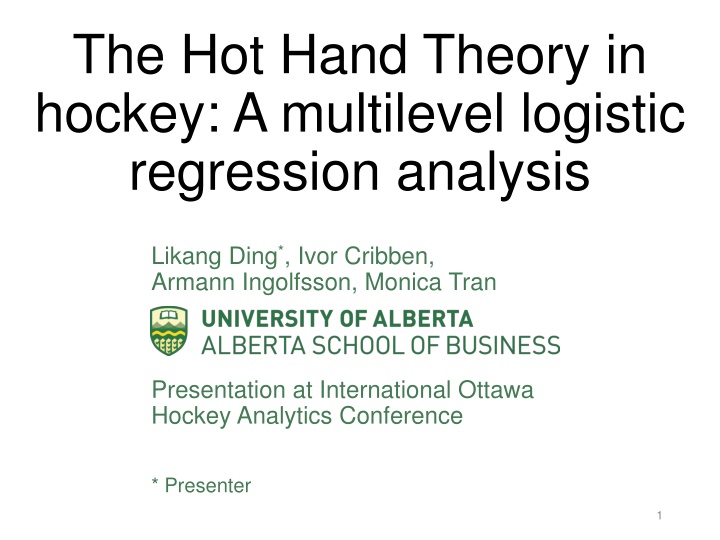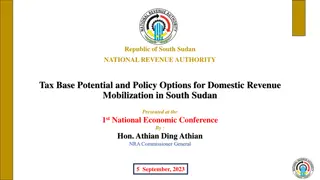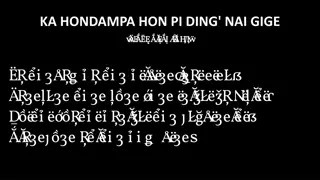
Analyzing Hot Hand Theory in Hockey: Insights from a Multilevel Regression Study
Dive into the analysis of streakiness in performance among goaltenders in hockey games, exploring factors influencing saving probability and the impact of recent player performance on saving probability in NHL playoffs. Data from 2008-2016 playoffs scrutinized through multilevel logistic regression.
Uploaded on | 1 Views
Download Presentation

Please find below an Image/Link to download the presentation.
The content on the website is provided AS IS for your information and personal use only. It may not be sold, licensed, or shared on other websites without obtaining consent from the author. If you encounter any issues during the download, it is possible that the publisher has removed the file from their server.
You are allowed to download the files provided on this website for personal or commercial use, subject to the condition that they are used lawfully. All files are the property of their respective owners.
The content on the website is provided AS IS for your information and personal use only. It may not be sold, licensed, or shared on other websites without obtaining consent from the author.
E N D
Presentation Transcript
The Hot Hand Theory in hockey: A multilevel logistic regression analysis Likang Ding*, Ivor Cribben, Armann Ingolfsson, Monica Tran Presentation at International Ottawa Hockey Analytics Conference * Presenter 1
Hot Hand Theory: A basketball player who has had a higher-than-average success on recent shots has a higher-than-average chance of scoring on the next shot The Theory was first analyzed by Gilovich, Vallone and Tversky in 1985 Although fans and NBA players believe in the Theory, the scholars analyses do not support it Their results actually suggest that a higher-than-average performance in the past would lead to lower-than-average probability of scoring on the next shot The Theory was studied by scholars for sports like basketball and baseball since the 1980s. 2
Two questions to answer Is there streakiness in the performance of goaltenders in hockey games? The answer would be no if the data was generated by i.i.d. Bernoulli trials If there is streakiness, do more successful trials in the past lead to a higher-than- average saving rate or lower-than-average saving rate on the next shot on goal? higher-than-average: confidence? lower-than-average: motivation? 3
Factors that may influence saving probability Individual level: Player Game level: Current game score Home or away ice Shot level: Shot origin Shot type 4
Our focus Goaltenders performance in NHL playoffs How does saving probability depend on player s recent performance, after controlling for other measurable factors? 5
Data: every shot during 2008- 2016 playoffs 36,235 shots 9 seasons 90 goaltenders 216 goaltender-year groups Group size: 1 to 678 shots Average size: 167.8 shots 6
Variables Dependent variable: Y = save (1) or goal (0) Independent variable: X = number of saves on last 5 shots Scaled by subtracting average Control variables: Z Home (1 or 0) Rebound (1 or 0) Strength (-2, -1, 0, +1, +2) Game score (lead, trail, tied) Shot type (categorical) Shot origin (2 specifications) 7
Shot types Backhand Deflected Slap Snap Tip-in Wrap-around Wrist 8
Shot origin: Distance + angle specification Angle Shot origin Image is a modified version of https://commons.wikimedia.org/wiki/File:InternationalRink.svg from Wikimedia Commons, licensed under GNU Free Documentation License v1.2. 9
Shot origin: Top + slot + corner specification Corner Slot Top Image is a modified version of https://commons.wikimedia.org/wiki/File:InternationalRink.svg from Wikimedia Commons, licensed under GNU Free Documentation License v1.2. 10
Multilevel logistic regression models No pooling:Separate models for every goalie- season combination Complete pooling: Single model for all goalie- seasons one intercept, one slope Partial pooling: Single model but intercept and slope can vary among goalie-seasons 11
Multilevel logistic regression models Scalars Vectors Pr ????= 1 = logit 1(???+ ???????+ ???????) No pooling: Complete pooling: Pr ????= 1 = logit 1(? + ?????+ ?????) Partial pooling: Pr ????= 1 = logit 1(???+ ???????+ ?????) ????= 1 if Goalie ? in Year ? made a save on Shot ? ???? is the number of saves in the most recent 5 shots prior to Shot ? for Goalie ? in Year ? ???? is the vector of control variables for Shot ? of Goalie ? in Year ? 12
Results of partial pooling and complete pooling models, number of saves on last 5 shots, top + slot + corner, within the same game Partial pooling Complete pooling Group Tim Thomas Devan Dubnyk Peter Budaj NA 2011 2015 2013 Slope/Fixed effect -0.13 -0.13 -0.13 -0.12 SE 0.038 0.038 0.038 0.037 Random effect -0.042 0.041 0.013 NA Group size 678 170 23 NA 13
Results of partial pooling and no pooling models, number of saves on last 5 shots, top + slot + corner, within the same game Partial pooling No pooling Group Tim Thomas Devan Dubnyk Peter Budaj Tim Thomas Devan Dubnyk Peter Budaj 2011 2015 2013 2011 2015 2013 -0.13 0.13 -0.13 Fixed effect Slope -0.17 -0.089 -0.12 -0.12 0.13 NA SE 0.038 0.038 0.038 0.34 0.43 NA Group size 678 170 23 678 170 23 14
Partial pooling results for slopes 0.2 Top + slot + corner model coefficients 0.1 0 -0.2 -0.1 0 0.1 0.2 -0.1 -0.2 Distance + angle model coefficients
Partial pooling results for shot type Wrap-around Backhand Wrist Slap Snap Top + slot + corner model Distance + angle model Tip-In Deflected 80% 82% 84% 86% 88% Save probability 90% 92% 94% 96% 98% 100% Group: Carey Price, 2008; Home; Non-rebound; Even strength; Shot Origin and game score variables set to their average values.
Partial pooling results for strength Goalie's team has 2 extra players Goalie's team has 1 extra player Even strength Goalie's team has 1 fewer player Top + slot + corner model Distance + angle model Goalie's team has 2 fewer players 80% 85% 90% 95% 100% Save probability Group: Carey Price, 2008; Home; Non-rebound; Shot Origin, shot Type and game score variables set to their average values.
Partial pooling results for game score Trail Tied Top + slot + corner model Lead Distance + angle model 80% 85% 90% 95% 100% Save probability Group: Carey Price, 2008; Home; Non-rebound; Even strength; Shot Origin and shot Type variables set to their average values.
Results for b = slope = coefficient of X, number of saves on last 5, 10 and 15 shots, top + slot + corner shot origin Last 5 shots Last 10 shots Last 15 shots Within the same game -0.13 Across different games Within the same game Across different games Within the same game Across different games Slope -0.11 -0.069 -0.089 -0.041 -0.076 SE 0.038 0.034 0.034 0.026 0.031 0.022 Sample size Slope ratio 36,235 43,028 28,631 42,055 21,235 41,145 1 1 0.53 0.81 0.32 0.69 19
Conclusion Results suggest that higher-than-average performance on past shots lead to lower-than- average saving rate on the next shot on goal. Motivations? 20
Contact info: Likang@ualberta.ca 21







